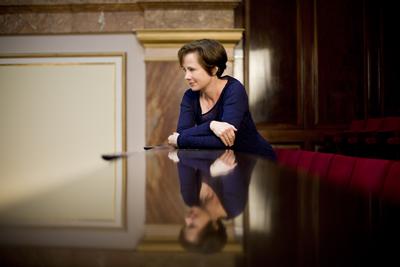From Monteverdi to Shakespeare

Southampton’s Head of Early Music Elizabeth Kenny has had a month of operatic contrasts, hurtling from the converted machine shed that is now a hub of experimental creativity, Camden’s Roundhouse, to the exquisitely reconstructed candlelit indoor theatre at the Globe, the Sam Wanamaker Playhouse.
Early last month she played theorbo in the large dark Roundhouse space for the acclaimed Michael Boyd production of Monteverdi’s Orfeo, (a collaboration with the Royal Opera House, and illuminated in its historical context in the programme notes by Southampton’s Valeria de Lucca). For the Globe, she devised and directed a smaller scale version of the Enchanted Isle, a dramatic opera based on Shakespeare’s The Tempest. The Enchanted Isle was flung together in 1674 by Thomas Betterton and a consortium of writers and composers, and yet became the enduring hit among many late seventeenth-century Shakespeare adaptations. The music - instrumental numbers by Matthew Locke and songs and masques by John Banister, Pelham Humfrey and Pietro Reggio – was provided by a team of soloists from the Orchestra of the Age of Enlightenment and singers including boy trebles playing intimidating Devils. The intimate acoustics and candles quite literally highlight the audience whose participation was encouraged by Caroline Williams’ adaptation of Davenant, Dryden and Shadwell’s text. Fruit was given out to the audience to signify the magical banquet the sailors find on the island, devils entered from the Playhouse’s trap door, and Ariel was given shape-shifting form by an actor and a singer from the top balcony. Actors from the Globe embodied all the characters from the sailors acoustically buffeted by Locke’s storm to Prospero, Ariel, Miranda, Ferdinand and Caliban, plus the extras brought on by the Restoration script team including Miranda’s sister Dorinda, and Hippolito, a youth who has never seen a woman.
Despite not being Shakespeare, the hybrid experience seemed to hit the spot:
With just two violins, a viola, a cello, a gamba, a hurdy-gurdy, a theorbo and what appeared to be a tennis ball in a tin (for thunder), lutenist Elizabeth Kenny and director Caroline Williams conjured up an intimate reduction of The Tempest in which Locke’s music was the focus... A mongrel entertainment but one of great charm, played stylishly by the soloists of the Orchestra of the Age of Enlightenment. (Times, 28 Jan 2015)
A forgotten corner of musical history has been brilliantly re-animated by the lutenist Elizabeth Kenny plus a group of her colleagues from the Orchestra of the Age of the Enlightenment…The candle-lit Wanamaker playhouse seems to confer magic on everything staged there, and so it was when Kenny and four other string players launched into Matthew Locke’s elegant introductory suite. Two actors (Molly Logan and Dickon Tyrrell) brought comic zest to the incarnation of Prospero, Ariel, Caliban, Miranda, et al; singers interwove a tissue of masques and dances with songs of the period, soprano Katherine Watson and tenor Samuel Boden being outstanding. (Independent 29 Jan 2015)
Kenny is back at the Wanamaker in February for Cavalli’s L’Ormindo, once again with scholarly framework provided by Valeria de Lucca.
Links to external websites
The University cannot accept responsibility for external websites.